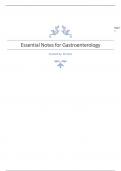Class notes
Essential Notes for Gastroenterology Finals (All you need for medical school finals)
- Course
- Institution
Author credentials - Top scorer medical school finals University of Sheffield 2022 - London Internal Medicine Trainee - Passed MRCP part 1 and part 2 - PGdiploma in medical education Features - All you need for final year medical school exams - Digital file editable Word document - PDF v...
[Show more]



